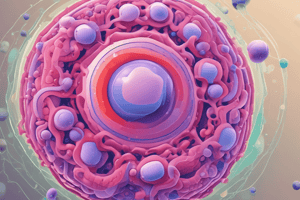Podcast
Questions and Answers
Which characteristic differentiates Staphylococcus saprophyticus from Staphylococcus epidermidis?
Which characteristic differentiates Staphylococcus saprophyticus from Staphylococcus epidermidis?
- Novobiocin resistance (correct)
- Coagulase negativity
- Urease positivity
- Catalase positivity
Where is Staphylococcus saprophyticus normally found in the body?
Where is Staphylococcus saprophyticus normally found in the body?
- Skin flora
- Female genital tract and perineum (correct)
- Intestinal tract
- Oral cavity
What is the Gram stain result for Staphylococcus saprophyticus?
What is the Gram stain result for Staphylococcus saprophyticus?
- Gram positive bacilli
- Gram negative bacilli
- Gram negative cocci
- Gram positive cocci (correct)
What type of infections does Staphylococcus saprophyticus commonly cause in young females?
What type of infections does Staphylococcus saprophyticus commonly cause in young females?
Which enzyme is produced by Staphylococcus saprophyticus?
Which enzyme is produced by Staphylococcus saprophyticus?
What characteristic allows Staphylococcus epidermidis to infect prosthetic devices and IV catheters?
What characteristic allows Staphylococcus epidermidis to infect prosthetic devices and IV catheters?
Which test would help differentiate between Staphylococcus epidermidis and Staphylococcus saprophyticus in a laboratory setting?
Which test would help differentiate between Staphylococcus epidermidis and Staphylococcus saprophyticus in a laboratory setting?
Which statement is exclusively correct for Staphylococcus saprophyticus?
Which statement is exclusively correct for Staphylococcus saprophyticus?
What is the least likely habitat for Staphylococcus epidermidis as normal microbiota?
What is the least likely habitat for Staphylococcus epidermidis as normal microbiota?
Which of these infections is Staphylococcus epidermidis most commonly associated with due to its biofilm-producing ability?
Which of these infections is Staphylococcus epidermidis most commonly associated with due to its biofilm-producing ability?
Study Notes
Staphylococcus saprophyticus Characteristics
- Gram-positive, catalase-positive, coagulase-negative, and urease-positive cocci that grow in clusters
Identification and Differentiation
- Resistant to novobiocin (in contrast to Staphylococcus epidermidis, which is novobiocin-sensitive)
Habitat and Prevalence
- Normal microbiota of the female genital tract and perineum
Clinical Significance
- Second most common cause of uncomplicated urinary tract infections (UTIs) in young females, after E. coli
Staphylococcus epidermidis
- Gram-positive, catalase-positive, coagulase-negative, urease-positive cocci that form clusters
- Sensitive to novobiocin
- Does not ferment mannitol, unlike Staphylococcus aureus which can ferment it
- Normal microbiota of skin, can contaminate blood cultures
- Infects prosthetic devices (e.g. hip implant, heart valve) and IV catheters by producing adherent biofilms
Staphylococcus saprophyticus
- Gram-positive, catalase-positive, coagulase-negative, urease-positive cocci that form clusters
- Resistant to novobiocin
- Normal microbiota of female genital tract and perineum
- Second most common cause of uncomplicated UTI in young females, after E coli
Studying That Suits You
Use AI to generate personalized quizzes and flashcards to suit your learning preferences.
Description
This quiz covers the characteristics of Staphylococcus saprophyticus, including its Gram reaction, enzyme production, and role in urinary tract infections.




